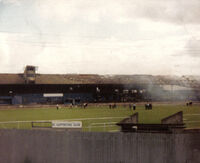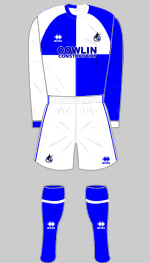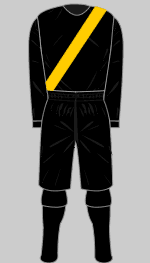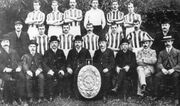Bristol Rovers Football Club is an English professional football team, based in Bristol, currently playing in nPower League One of the Football League.
The club were founded in 1883 as Black Arabs F.C., and changed their name to Eastville Rovers in 1884. The name changed again briefly in 1897 to Bristol Eastville Rovers, before finally changing to Bristol Rovers in 1898.[1]
The club's official nickname is The Pirates, reflecting the maritime history of Bristol. The local nickname of the club is The Gas, from the gasworks next to Eastville Stadium, their former home. Their main rivals are Bristol City, and according to a survey conducted in December 2003, Cardiff City and Swindon Town are considered the second and third biggest rivals.[2]
Rovers currently play at the Memorial Stadium, where they have played since August 1996. The ground was due to be demolished in late 2007 and rebuilt as an 18,500 capacity all-seater stadium.[3] but this was delayed until May 2008.[4]. In June 2008 it was announced a further delay meant that the stadium would be delayed until the summer of 2009 at the earliest[5].
History[]
The club was formed following a meeting at the Eastville Restaurant in Bristol in September 1883. They initially went by the name Black Arabs F.C., the name coming from the Arabs rugby team and the predominantly black kits in which they played.[1] This name only lasted for the 1883-84 season, and in a bid to draw more fans from the local area the club was renamed Eastville Rovers in 1884.

Aftermath of the fire at Eastville Stadium, August 1980
The club played only friendly games until the 1887-88 season, when they took part in the Gloucestershire Cup for the first time. They first joined a league in 1892, when they became a founder member of the Bristol & District League, which three years later was renamed the Western League. In 1897 Eastville Rovers joined the Birmingham & District League, and for two seasons played in both this league and the Western League.[6] At the beginning of the 1897-98 season, the team turned professional and changed their name to Bristol Eastville Rovers,[6] and on 17 February 1899 the name was officially changed to Bristol Rovers.[1]
In 1899 Bristol Rovers joined the newly-formed Southern League, where they remained until 1920. For the 1920-21 season, the Southern League teams were moved into the new Football League Division Three, which became Division Three (South) the following season. They remained in this division for over 30 years, before winning the league, and promotion in the 1952-53 season.[1]
Promotion has been won by the team on three occasions, in 1973-74 from the Third Division to the Second Division, again in 1989-90 as Division Three champions and also in 2006-07 to Football League One. The team have been relegated four times in their history - in 1961-62, 1980-81, 1992-93 and most recently at the end of the 2000-01 season, when the team were relegated to the fourth level of league football for the first time in their history.
The only major cup competition won by Bristol Rovers is the 1972 Watney Cup, when Sheffield United were beaten in the final. The club also won the Division Three (South) Cup in 1934-35, as well as winning or sharing the Gloucestershire Cup on 32 occasions. The team have never played in European competition, the closest they came was when they missed out on reaching the international stage of the Anglo-Italian Cup in the 1992-93 season on a coin toss held over the phone with West Ham United.[7] They have twice reached the final of the Football League Trophy, in 1989-90 and 2006-07, but finished runners-up on both occasions.
Colours and badge[]

Bristol Rovers team kit for the 2007-08 season. Copyright Historical Football Kits and reproduced by kind permission.
Bristol Rovers are known for their distinctive blue and white quartered shirts, which they have worn for most of their existence. The current kit consists of a blue and white quartered shirt, white shorts and blue socks and the away kit is green with a black trim.
The team began playing in black shirts with a yellow sash from their foundation in 1883 as Black Arabs F.C. until 1885, by which time they were called Eastville Rovers. For the next fourteen years, until 1899, the team wore blue and white hooped shirts. These were replaced by black and white striped shirts until 1919.[7]

Bristol Rovers team kit for the 1883-84 season. Copyright Historical Football Kits and reproduced by kind permission.
When Rovers were admitted to The Football League in 1920 they wore white shirts with blue shorts. These remained the team colours until 1930, when the colours were reversed to blue shirts and white shorts for one season.[7] The blue and white quarters were first worn in 1931, when they were introduced to try and make the players look larger and more intimidating.[1] Rovers continued to wear the quarters for 31 years until they were replaced by blue pinstripes on a white background.
Over the next ten years, Rovers went on to wear blue and white stripes, all blue, and blue shirts with white shorts before returning to the blue and white quarters in 1973, which have remained the colours ever since.[7] During the 1996-97 season, Rovers wore an unpopular striped quartered design, prompting fans to refer to it as the Tesco bag shirts[8] because of their similarity to the design used for the company's carrier bags. The change in design prompted the Trumpton Times fanzine to change its name to Wot, No Quarters?[9]

Club badge used during the 1980s and 90s
The black and gold shirts were also used as the away kit for the 2002-03 season, to mark the 120th anniversary of the club. In 2007, the club reverted to a far lighter shade of blue, but the royal blue returned the following year.
In 2005, Rovers ran an April Fools' joke on their official website, stating that the team's new away strip would be all pink. Although this was intended to be a joke, a number of fans petitioned the club to get the kit made for real, and also suggested that funds raised through the sale of the pink shirts should be donated to a breast cancer charity.[10] Although the pink shirts were never used in a competitive fixture, they were worn for a pre-season friendly against Plymouth Argyle in 2006.[11]
A pirate features on both the club badge and the badge of the supporters club,[12] reflecting the club's nickname of The Pirates.
Stadium[]
| Dates | Ground |
|---|---|
| 1883-1884 | Purdown |
| 1884-1891 | Three Acres |
| 1891-1892 | Schoolmasters Cricket Ground |
| 1892-1894 | Durdham Down |
| 1894-1897 | Ridgeway |
| 1897-1986 | Eastville Stadium |
| 1986-1996 | Twerton Park |
| 1996-present | Memorial Stadium |
Home games are now played at The Memorial Stadium, Filton Avenue, Horfield, a ground they share with Bristol Rugby Club. The team moved to The Mem, as it is known informally, at the beginning of the 1996-97 season, initially as tenants but Rovers purchased the ground two years later.[13]
When Bristol Rovers were known as Black Arabs F.C. in 1883, they played their home games at Purdown, Stapleton. The following year they moved to Three Acres, the precise location of which is not known, but is believed to have been in the Ashley Down area of Bristol, where they remained for seven years. This was followed by brief stays at the Schoolmasters Cricket Ground, Durdham Down and Ridgeway.

The Memorial Stadium as viewed from the Centenary Terrace
For the majority of their history, Bristol Rovers played their home games at Eastville Stadium, where they remained for a period of 89 years from 1897-1986. Financial problems led to the team being forced to leave Eastville, and they found a temporary home at Twerton Park, the home of Bath City. They stayed in Bath for 10 seasons, before returning to Bristol in 1996.
Rovers have also played home games at Ashton Gate following a fire which destroyed one of stands at Eastville, and also for one match during the early days of the period spent in Bath. During World War II, some friendly matches were played at Kingswood, and in their early history some games were played at Parson Street, Bedminster[1]
On 17 January 2007 planning permission was granted for a new 18,500 capacity all-seater stadium to be built on the site of the Memorial Stadium.[14] The stadium will also include student accommodation, a hotel, convenience store and restaurant.[15] Building work was originally intended to begin late in 2007, but on August 17 2007 it was announced that the redevelopment had been delayed and was to begin in May 2008.[16] A further delay caused by the student accommodation provider pulling out of the project means Rovers will now be away from the Memorial Stadium from the start of the 2009-10 season. Rovers had agreed a deal to play their home games at Cheltenham Town's Whaddon Road ground,[17] but the delays mean their temporary home is still to be finalised.
Supporter culture[]

Rovers fans at the Johnstone's Paint Trophy final at the Millennium Stadium, Cardiff in 2007
The team traditionally draws the majority of its support from north and east Bristol[18] and South Gloucestershire. Many towns and villages in the surrounding area are also home to significant pockets of Rovers supporters.
The nickname given to Bristol Rovers supporters is Gasheads. The Gas was originally coined as a derogatory term by the supporters of Bristol Rovers' rivals Bristol City and was in reference to the large gas works adjacent to the old Bristol Rovers stadium, in Eastville, which wafted the sometimes overpowering odour of town gas across the crowd.
Gasheads was adopted as a name by a splinter group of Rovers supporters in the mid-1980s to early 1990s. The chant 'Proud to be a Gashead' spread to regular fans and a fanzine was produced called The Gashead.
The term 'Gasheads' is now universally accepted within the English media and football fraternity as referring to Bristol Rovers supporters. After the club's relegation to League Two in 2001, the club designated the squad number 12 to the Gasheads to signify them as the club's 12th Man in recognition of their loyal support.
Club song[]
The song which is synonymous with Rovers is "Goodnight, Irene", which was written by Leadbelly.[19] It is sung by fans in support of the team.
Opinions differ as to how this came about but it is thought to have become popular in the 1950s when a version of the song was in the British charts - the line "sometimes I have a great notion to jump in the river and drown" - seemed to be particularly apt when Rovers lost as the Bristol Frome flows alongside the old Eastville ground.[20]
Another theory is that it was sung at a fireworks display at the Stadium the night before a Home game against Plymouth Argyle in the fifties. During the game the following day, Rovers were winning quite comfortably and the few Argyle supporters present began to leave early prompting a chorus of "Goodnight Argyle" from the Rovers supporters - the tune stuck and "Irene" became the club song.[1]
Players[]
- For the current squad, see current squad.
Notable players[]
| Years | Nat | Player | Achievement |
|---|---|---|---|
| 1946-60 | Jackie Pitt | Played 466 league games and spent over 50 years at the club as a player, coach and groundsman. | |
| 1949-64 | Geoff Bradford | Rovers' record goal scorer with 242 league goals from 462 appearances. The only player to be capped by England while at Bristol Rovers. | |
| 1962-63 | Esmond Million | Goalkeeper who was banned from football for life for accepting a bribe. | |
| 1966-80 | Stuart Taylor | More league appearances than any other Rovers player (546) | |
| 1971-77 | Bruce Bannister | Became nationally known as Smash & Grab during the 1970s for their goalscoring ability. | |
| 1973-77 | Alan Warboys | ||
| 1956-69 | Ray Mabbutt | Father and son who played in 526 league games for the club between them. Gary was later capped 16 times for England. | |
| 1979-82 | Gary Mabbutt | ||
| 1981-85 1987-91 1996-99 |
Ian Holloway | Three spells at the club as a player and a manager. Named the fans' Cult Hero in a BBC poll.[21] | |
| 1983 | Alan Ball | Only World Cup winner to play for Rovers. Ended his playing career at the club. | |
| 1984-90 1997-00 |
Gary Penrice | Two spells at the club as a player and a Coach. Ended his playing career at the club. | |
| 1987-89 | Nigel Martyn | Became the first million pound goalkeeper when he was sold to Crystal Palace. | |
| 1992-00 | Andy Tillson | Record signing, and former club captain. | |
| 1997-99 | Barry Hayles | Club record sale when he moved to Fulham for £2,100,000. | |
| 2000-03 | Vitālijs Astafjevs | Most capped Bristol Rovers player - over 100 caps for Latvia |
Management[]
Management team[]
| Job title | Name[22][23] |
|---|---|
| First team coach | Paul Trollope |
| Physio | Phil Kite |
| Goalkeeping coach | Steve Book |
Notable former managers[]
| Years | Manager | Achievement |
|---|---|---|
| 1899-1920 | Alfred Homer | Rovers' first and longest-serving manager. |
| 1920-1921 | Ben Hall | Rovers' first manager in the Football League. |
| 1930-1936 | Albert Prince-Cox | Introduced the blue and white quartered shirts. Won the Division Three (South) Cup in 1934-35. |
| 1950-1968 | Bert Tann | Rovers' longest serving post-war manager (18 years). Division Three (South) champions 1952-53. |
| 1972-1977 | Don Megson | Won the Watney Cup in 1972 |
| 1981 | Ron Gingell | Shortest spell by anyone as Rovers' manager (1 game) |
| 1981-1983 1985-1987 |
Bobby Gould | Two spells as manager in the 1980s |
| 1987-1991 2001 |
Gerry Francis | Division Three champions 1989-90 |
Youth setup[]
The Bristol Rovers centre of excellence is associated with the Bristol Academy of Sport, located at Filton College, which offers a college education along with football coaching.[24] Current squad members Sean Rigg, Tom Parrinello, Lewis Powell, Chris Lines and Mike Green all graduated from the Academy to earn a professional contract. Perhaps the most successful former member of the academy is Scott Sinclair, who was signed by Chelsea in 2005 for an initial fee of £200,000, with further payments to the club possible, depending on performance.[25]
Women's Team[]

Bristol Academy v Birmingham City, October 2006
The club boast a successful women's team, formed in 1998 as Bristol Rovers W.F.C. and now known as Bristol Academy W.F.C.. They play in the top flight of women's football in England, the FA Women's Premier League National Division, and have won ten trophies since their formation, as well as reaching the semi-finals of the FA Women's Cup on five occasions.[26]
Achievements[]
- Southern League Division One - 1 (1904-05)
- Division Three (South) - 1 (1952-53)
- Division Three - 1 (1989-90)

1904-05 Southern League winning team.
- League Two play-offs - 1 (2006-07)
- Division Three (South) Cup - 1 (1934-35)
- Watney Cup - 1 (1972)
- Football League Trophy, Southern Section - 2 (1989-90, 2006-07)
- Gloucestershire Cup - 32 (1888-89, 1902-03, 1904-05, 1913-14, 1924-25, 1927-28, 1934-35, 1935-36, 1937-38, 1947-48, 1948-49, 1950-51, 1953-54, 1954-55, 1955-56, 1958-59, 1962-63, 1963-64, 1964-65, 1965-66, 1967-68, 1973-74, 1974-75, 1981-82, 1982-83, 1983-84, 1984-85, 1988-89, 1989-90, 1992-93, 1993-94, 1994-95)
Records[]
Scorelines:[]

Bristol Rovers record goalscorer, Geoff Bradford. Picture taken in 1988, when he was 61 years old.
- Biggest League Win:[27]
- 7-0 (v Brighton & Hove Albion, Division Three (South), 29 November 1952)
- 7-0 (v Swansea City, Division Two, 2 October 1954)
- 7-0 (v Shrewsbury Town, Division Three, 21 March 1964)
- Biggest Cup Win:
- Biggest League Defeat: 0 - 12 (v Luton Town, Division Three South, 13 April 1936)[28]
Players:[]
- Most League Appearances: 546 - Stuart Taylor, 1966 - 1980[29]
- Most Goals for club: 242 - Geoff Bradford, 1949 - 1964[29]
- Most Goals in a season: 33 - Geoff Bradford, 1952-53[29]
- Highest Transfer Fee Paid: £375,000 - Andy Tillson from Queens Park Rangers, November 1992[29]
- Highest Transfer Fee Received: £2,100,000 - Barry Hayles to Fulham, November 1998[29]
Other:[]
Source[]
| This page uses Creative Commons Licensed content from Wikipedia (view authors). | 
|
References[]
- ↑ 1.0 1.1 1.2 1.3 1.4 1.5 1.6 1.7 Byrne, Stephen & Jay, Mike (2003), Bristol Rovers Football Club: The Definitive History 1883-2003. Tempus Publishing, Stroud. ISBN 0-7524-2717-2
- ↑ Club rivalries uncovered (PDF) Football Fans Census. Retrieved 16 February 2007
- ↑ A new Memorial Stadium (HTML). bristolrovers.co.uk. Retrieved on 2007-05-11.
- ↑ Football and rugby stay in city (HTML). BBC News. Retrieved on 2007-10-17.
- ↑ Delay over Rovers stadium plans (HTML). BBC News. Retrieved on 2008-06-03.
- ↑ 6.0 6.1 Into the league bristolrovers.co.uk. Retrieved 11 February 2007
- ↑ 7.0 7.1 7.2 7.3 Rovers FAQ bristolrovers.co.uk. Retrieved 12 February 2007
- ↑ Bristol Rovers - Historical Kits (HTML). Historical Football Kits. Retrieved on 2007-05-09.
- ↑ About us Black Arab fanzine. Retrieved 13 February 2007
- ↑ Bristol Rovers fans are pretty in pink (HTML). BBC Bristol. Retrieved on 2007-05-14.
- ↑ Walker strike sinks Pilgrims (HTML). bristolrovers.co.uk. Retrieved on 2007-05-14.
- ↑ Bristol Rovers Supporters Club logo bristolroverssc.co.uk. Retrieved 30 April 2007
- ↑ Back to Bristol bristolrovers.co.uk. Retrieved 7 February 2007
- ↑ Memorial Stadium given go-ahead from BBC News. Retrieved 18 January 2007.
- ↑ Planning Consultation:Memorial Stadium, Filton Avenue Bristol City Council. Retrieved 30 April 2007
- ↑ Football and rugby stay in city BBC News. Retrieved 30 October 2007
- ↑ Rovers confirm Cheltenham switch. BBC Sport (5 June 2007). Retrieved on 5 June 2007.
- ↑ Bristol City vs. Bristol Rovers (HTML). Football Derbies.com. Retrieved on 2007-05-09.
- ↑ Goodnight, Irene Harry Lewman Music. Retrieved 30 April 2007
- ↑ Rovers FAQ bristolrovers.co.uk. Retrieved 30 April 2007
- ↑ Bristol Rovers' cult heroes BBC Sport. Retrieved 30 April 2007
- ↑ Management team from bristolrovers.co.uk. Retrieved 28 November 2006.
- ↑ Clark is handed Rovers youth role (HTML). BBC Sport. Retrieved on 2007-11-06.
- ↑ Bristol Rovers U18s Filton College. Retrieved 30 April 2007
- ↑ Chelsea compensation figures confirmed The Football League. Retrieved 30 April 2007
- ↑ Women's team: History & honours bristolrovers.co.uk. Retrieved 30 April 2007
- ↑ 27.0 27.1 27.2 Dates & Honours bristolrovers.co.uk. Retrieved 9 February 2007
- ↑ Bristol Rovers sportingchronicle.com. Retrieved 9 February 2007
- ↑ 29.0 29.1 29.2 29.3 29.4 Rollin, Glenda & Rollin, Jack (2006):Sky Sports Football Yearbook 2006-2007. ISBN 0-7553-1526-X